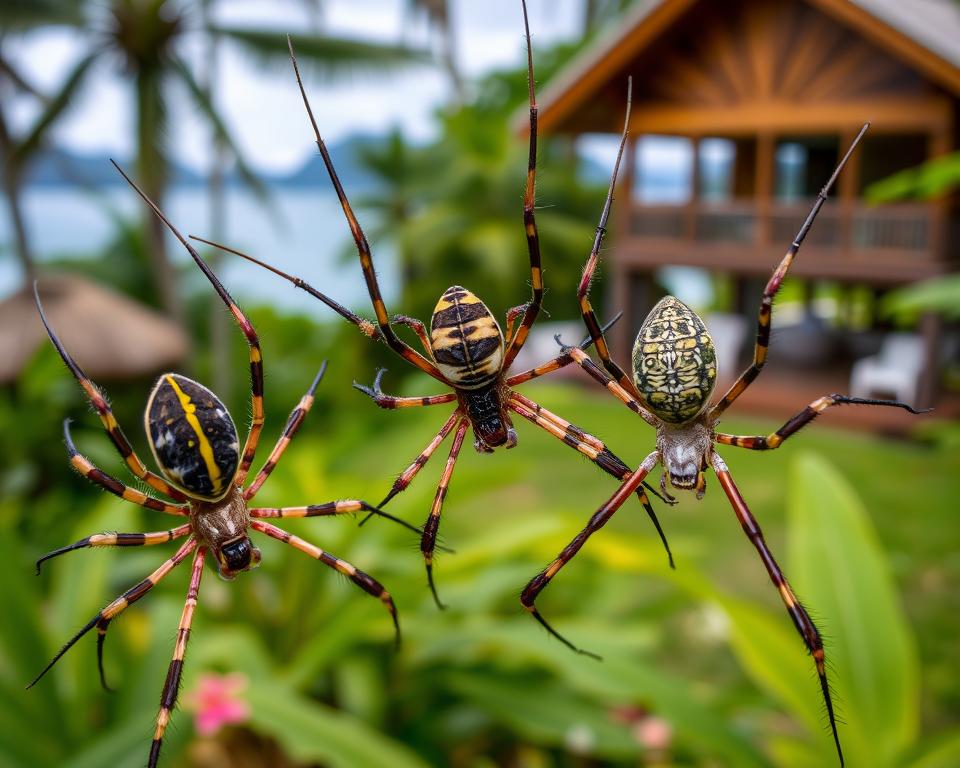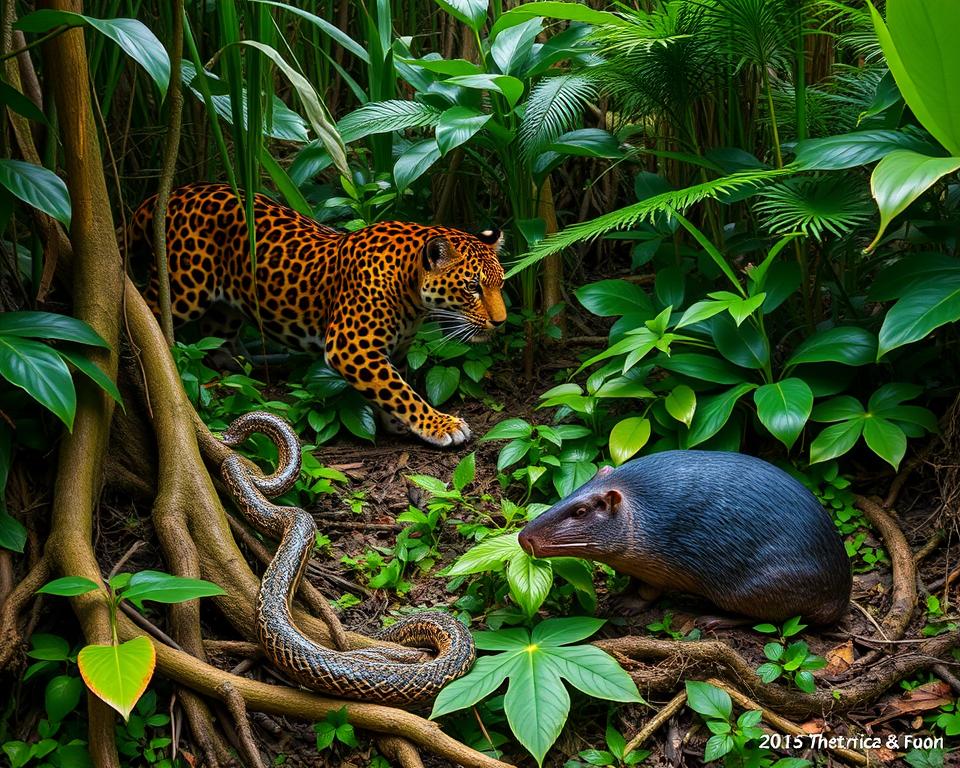Costa Rica’s Dangerous Animals: Risks & Safety
Have you ever wondered what lurks behind Costa Rica’s stunning landscapes? The country is famous for its beauty and biodiversity. But, it also has dangerous animals that can be a risk to travelers. Knowing about these dangers helps us respect and safely share space with Costa Rica’s wildlife.
This guide will tell you about the dangers in Costa Rica. We’ll focus on the risks and how to stay safe. This way, you can enjoy the amazing ecosystems without danger.
Key Takeaways
- Costa Rica has about 22 species of venomous snakes, highlighting the high likelihood of encounters, especialy in rural areas.
- The country is home to over 2,000 spider species, including some with potentially lethal bites.
- Understanding the dangers of the bullet ant, known for its excruciating sting, is crucial for safety in tropical rainforests.
- Essential precautions, such as maintaining a safe distance from wildlife like jaguars and pumas, can prevent dangerous encounters.
- Awareness of marine life hazards, such as bull sharks and stingrays, enhances safety in Costa Rica’s waters.
- Following local guidelines and safety measures is vital for enjoying Costa Rica’s natural beauty while minimizing risks.
Introduction to Costa Rica’s Wildlife
Costa Rica is famous for its incredible biodiversity. It’s home to over 500,000 species across different ecosystems. From the coast to the rainforests, life is abundant. National parks like Tortuguero and Corcovado show the success of conservation efforts.
Bird lovers can see about 850 species in these areas. Those interested in exotic animals in costa rica will find mammals like monkeys, sloths, and iguanas. For example, Costa Rica has four types of monkeys. Squirrel monkeys, known for their fun nature, live in groups of 30 during the dry season.
Costa Rica is dedicated to conservation. Over a quarter of its land is protected. This helps species like the jaguar and the American crocodile thrive. The jaguar has about 15,000 wild individuals, and the crocodile is vulnerable, showing the need to protect its home.
The Importance of Understanding Wildlife Risks
Knowing the dangers of costa rica wildlife is key for anyone exploring this lively ecosystem. It helps keep you safe and supports conservation. Costa Rica’s varied habitats are home to many species, including aggressive mammals and venomous reptiles.
Being aware of dangerous animals makes your trip better by keeping you safe from harm. When you’re out exploring, knowing which animals to steer clear of helps. This way, you respect the wild and its creatures.
Learning about costa rica’s dangerous animals helps you stay safe while enjoying its beauty. With the right knowledge, you can have a safe and memorable adventure in Costa Rica’s wild.
About Costa Rica’s Dangerous Animals
Costa Rica is famous for its diverse wildlife. It has many dangerous creatures living in its jungles, coastlines, and mountains. The Fer-de-Lance snake and the jaguar are two examples of these dangerous animals.
It’s important to know about these animals if you plan to explore the outdoors. Knowing their habits and habitats helps keep you safe. For example, the Brazilian Wandering Spider can be hidden in thick foliage and has dangerous venom.
When you’re in Costa Rica, always stay safe. Keep a distance from dangerous animals to avoid risks. Knowing your surroundings and being prepared makes your trip safer and more fun.
Common Venomous Snakes in Costa Rica
Costa Rica has many venomous snakes that can be dangerous. It’s important to know about these snakes to stay safe. The country has 22 venomous snake species, including the Fer-de-Lance and Bushmaster. Knowing how to spot these snakes can help avoid dangerous situations.
Identifying Dangerous Snake Species
Some venomous snakes in Costa Rica are more dangerous than others. Here are a few examples:
- Fer-de-Lance (Bothrops asper): This snake has a brown pattern and is very venomous. It lives in rainforests and farmlands.
- Eyelash Palm Pit Viper (Bothriechis schlegelii): It has green color with eye-like markings. Its venom is moderate to severe, found in wet lowlands.
- Bushmaster (Lachesis spp.): It’s one of the biggest venomous snakes, over 3 meters long. It has V-shaped markings.
- Central American Coral Snake (Micrurus nigrocinctus): It’s beautiful but very dangerous. Its venom is highly toxic and needs quick medical help.
Understanding Snake Bite Risks
Knowing about snakes and staying alert can lower the risk of bites. There are about two snakebite cases per hectare each year. Most happen in rural areas.
The Terciopelo and Central American Rattlesnake cause many bites. This leads to hospitalizations. Wearing protective gear and being careful in forests is key. Knowing about snakes and being careful is important for enjoying Costa Rica’s beauty safely.
Deadly Insects of Costa Rica
Costa Rica is known for its rich biodiversity. This includes many deadly insects that can be a risk for visitors. The Bullet Ant (Paraponera clava) is one of the most painful insects in the world. They are found in some areas and can sting very painfully.
The Tarantula Hawk Wasp is also a threat. Its sting is very painful, but it only attacks when provoked. Bee species are another danger, as they can cause severe allergic reactions in some people.
These insects show why it’s important to be careful in Costa Rica. Knowing about these insects and their behavior can help avoid dangerous situations. This knowledge is key to staying safe while exploring this beautiful country.
Exploring the Threats of Stinging Insects
There are ways to reduce the risks from these insects. Here are some tips:
- Wear protective clothing that covers exposed skin.
- Use insect repellent containing effective ingredients.
- Avoid disturbing nests or swarms of insects.
- Remain vigilant in high-risk areas, specially during specific seasons.
By following these tips, visitors can enjoy Costa Rica’s beauty safely. This way, they can see the stunning wildlife without worrying about dangerous insects.
Lethal Spiders Found in Costa Rica
Costa Rica is home to many lethal spiders. The Brazilian Wandering Spider is one of the most dangerous. It has a powerful neurotoxin that can paralyze humans. It’s important to be careful in areas where these spiders might be found.
Knowing where these spiders live helps avoid dangerous encounters. They often hide in dark spots, under rocks, and in leafy areas. This knowledge can greatly reduce the risk of meeting them.

The orange-kneed tarantula is another dangerous spider in Costa Rica. It can grow up to six inches wide. Its venom is strong for its prey but only mildly irritating to humans.
These spiders mainly eat insects but sometimes small animals. They are not endangered yet. But, their homes are being lost, and they are in danger from the pet trade.
Knowing how these spiders behave helps keep you safe. By understanding their habits, you can explore Costa Rica safely. This way, you can enjoy its beauty while watching out for these deadly spiders.
Hazardous Reptiles in Costa Rica’s Ecosystem
Costa Rica is famous for its rich wildlife, including many dangerous reptiles. Some of these creatures can be a big threat to those who love the outdoors. It’s important to be careful around the venomous snakes and certain lizards. Knowing about the dangers can help keep you safe while exploring this beautiful place.
Recognizing Poisonous Lizards
Most lizards in Costa Rica are safe, but some can be toxic. The poisonous lizards have bright colors that warn of their danger. Knowing which ones to watch out for is key to staying safe. Here are some tips to avoid dangers from Costa Rica’s reptiles:
- Keep a safe distance when observing lizards and snakes.
- Be mindful of your surroundings, specially in rocky or densely vegetated areas.
- Wear appropriate footwear to protect your feet from potential encounters.
- Consult local resources to identify specific reptiles common to the area.
- Respect their habitats to reduce unnecessary interactions.
Dangerous Mammals in Costa Rica
Costa Rica is full of mammals, some of which are dangerous. Travelers might see amazing wildlife but also animals that could be deadly. The jaguar, a top predator, is rare to see but powerful. Pumas are also stealthy and strong, but they usually avoid humans.
Smaller mammals like tapirs have their own ways of defending themselves. They can get territorial and might act aggressively if surprised. It’s important to know how to stay safe around these animals.

It’s smart for visitors to learn about local wildlife rules and how to interact with nature. Getting too close to a tapir can be risky. Being careful and respectful helps ensure safe adventures in Costa Rica’s beautiful nature.
Exploring Aquatic Hazards in Costa Rica
Costa Rica’s coastlines and rivers offer stunning views but hide dangers. Visitors swimming, snorkeling, or surfing face risks from aquatic hazards in Costa Rica. Bull sharks, stingrays, and venomous fish are common, posing threats.
To stay safe, it’s crucial to know where these animals live. Following Costa Rica swimming safety tips is essential. Swimming in designated areas can greatly reduce risks, making your experience safer and more enjoyable.
Many ocean injuries happen during water activities. Staying alert and informed is vital in Costa Rica’s varied water environments. For more on wildlife safety, check out this link.
How to Stay Safe Around Deadly Animals of Costa Rica
Exploring Costa Rica’s wildlife is exciting, but safety is key. Knowing how to stay safe around animals is crucial. It ensures you enjoy wildlife without risking your safety or theirs. Learning about wildlife safety in Costa Rica helps avoid accidents and supports eco-tourism.
Practical Wildlife Safety Tips
Here are some tips for a safe adventure:
- Stay on marked trails to avoid dangerous animals.
- Keep a safe distance from all wildlife to avoid attacks.
- Wear closed-toe shoes to protect against bites or stings.
- Choose guides who know a lot about local wildlife.
- Avoid sudden movements to not scare animals.
Knowing about local animals and talking to guides and locals makes your trip better. It also shows respect for Costa Rica’s nature. The National System of Conservation Areas (SINAC) and the Costa Rican Tourism Institute (ICT) work hard to keep visitors and animals safe. By following these tips, you help protect yourself and support wildlife conservation.
Conclusion
Knowing about Costa Rica’s dangerous animals is key for anyone wanting to explore the country. This guide helps travelers understand the risks from venomous snakes to aggressive mammals. By being aware, visitors can enjoy Costa Rica’s beauty safely.
Adventurers should follow wildlife safety tips in Costa Rica. Learning to spot dangerous animals and how to react during encounters is crucial. Also, being respectful helps protect these amazing creatures and their homes.
Travelers can enjoy Costa Rica’s stunning nature and wildlife safely with the right knowledge. This approach creates a balance between enjoying nature and keeping safe. It makes every outdoor adventure unforgettable and secure.




